 Sundari-chan |

|
Summary
This is a cosplay build/reminiscence for the Garnet Rod, also known as the Time Key: the key-shaped staff wielded by Sailor Pluto. It was the first cosplay thing I’ve made, so it’s quite primitive. Nevertheless, I’m happy with how it turned out, and I think it looks very authentic to the anime. I didn’t take many photos of the progress, so I’ll reconstruct the build as best I can.
Background
My wife started cosplaying in 2004, and her first cosplay was to be of Sailor Pluto. I offered to make the staff for her. At the time, we lived in a small apartment without many tools, but some friends of ours did a lot of cosplay, so I abused their hospitality and used some of their equipment. I built the staff over the course of a couple of months, coming over to the friends’ place on some weekends, working in our apartment at other times.
Planning
I printed an image of the staff full size, to my wife’s scale, on a bunch of sheets of paper taped together. I used an inconsistent scale – the height of the staff and its thickness are scaled to my wife’s height and width relative to the height and width of Sailor Pluto, respectively, rather than matching the same scale. I think this maintains a realistic approximation of the overall character design.
Supplies
Materials
The body of the staff is made of segments of 3/4″ and 1″ dowels, with 1/4″ steel rods to connect and strengthen. The balls are 1.5″ and 2″ diameter wooden balls I got at Michael’s, the key bits are 1/4″ plywood. The carved capital between the body and head is a piece of 4×4, and the curved head is a 1″ piece of oak (which was a pain to carve, believe me). The yellow spheres are marbles, and the red sphere is a christmas ornament.
Tools
For tools, I used our friends’ dremel, power sander and hand saws. I also bought a vise and attached it to a ramshackle wooden platform so I could take it around with me. Aside from that, all I used was a hand power drill.
The Build
Body
There are four dowels put together end-to-end, connected with the steel rods. The first step was to cut the dowels to length.
There’s one main long dowel, and then three short ones at the end, alternating between 3/4″ and 1″ to match the staff’s design. I sanded the very lowest one to taper it.
Dowel placement:
Note that the dowels go through the 1.5″ balls. The next step was to drill out those balls, with 3/4″ holes. This was pretty tough, and I broke about half the balls I tried to drill. Fortunately, they came in a fairly large bag.
Next, I drilled holes for the two steel rods. One went through the bottom set of dowels, the other through the top dowel, into the intermediate piece, and then up through the head of the key. The bottom rod goes through the bottom ball and juts out a little, so that when you rest the staff on the ground, it rests on metal.
Steel placement:
Drilling holes for the steel rods was the toughest task. I clamped the pieces in the vise, and took my time drilling and readjusting the alignment. For pieces that had to be drilled all the way through, I drilled separately from the two ends. Despite this, the holes weren’t perfectly aligned, but I tried to match angles when putting the thing together so the errors offset one another.
Once this was done, I drilled out the last (2″) ball to fit the rod and a bit of the last dowel through it, and attached the four pieces of dowel together. If I recall correctly, I used epoxy.
One more task for the body was to drill notches adjacent to each ball. To get a reasonably even pattern, I clamped the dremel in the vise, and then rotated the dowel against the blade.
Key Jigs
I cut the key jigs out of 1/4″ plywood, and attached them by dremeling out notches in the staff, then gluing the key bits with epoxy. This was pretty uneventful, aside from one moment when I drove a saw through my hand and used up all the earlier mentioned friends’ gauze. The epoxy has held admirably over the years. (And I had scars for a while, but can no longer find them.)
One of the few photos I have of progress:
Staff body at the bottom, printed out schematic at upper left, head of the staff left of top center.
Capital
The carved part at the top of the staff was a pain. I made it out of a 4×4 piece of pine which I first sanded down to a tapered piece, then dremeled out to carve the grooved shape. It took forever, and the result isn’t terribly even, but it’s okay. I also drilled a hole all the way through this piece for the steel core.
Head
The head of the staff is a single piece of oak, hand-sawed, then sanded and dremeled to coerce it into the right shape. Quite tough work.
Attaching the capital and head
I attached the capital and head the same way as the bottom sections – steel rod through the center, glued together with epoxy.
Another random progress shot: trimming the steel rod to match the size of the head piece.
Gems
The red gem was easy — it’s just a christmas ornament painted on the inside. The technique was well known even at the time, and works nicely.
The yellow gems were a pain. First, it’s not easy to find plain-colored marbles. I eventually got some translucent-beige ones you see in the above photo. Fitting and attaching the small 1/4″ one was no problem.
However, attaching the 1/2″ large ones proved problematic. I tried a variety of glues (epoxy, superglue, etc.), but the marbles are heavy for their size, and the surface (even sanded down) doesn’t take glue well. They’d stick, but every time my wife would smack the staff against the ground (even lightly), the marbles would scatter everywhere. The third time this happened, I decided something tougher was needed.
To attach the marbles better, I decided to drill holes in them and use heavy guage wire (nails with the heads snipped off) to connect them. This meant I needed opaque marbles. I tracked down some yellow ones, but could only find the 1/2″ size, not the 1/4″, so now they don’t match. :/ If anyone finds a 1/4″ matching yellow marble, do please let me know.
Drilling was very tough. Even with a glass drill bit, I had trouble making headway, and a bunch of marbles cracked and split. Still, I was able to get it done.
Nail placement:
Gluing this together with epoxy worked out quite well, and none of the marbles have popped off since then.
Paint
The final step was to paint. (Actually, it was a couple of steps earlier, but logically the last step.) I used a nice blue metallic acrylic paint from Michael’s. Nothing fancy, and when you look close, you can see wood grain. From a distance, however, it looks perfect.
Photos
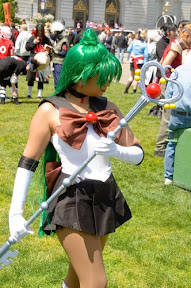 Sundari-chan |
 Sundari-chan |
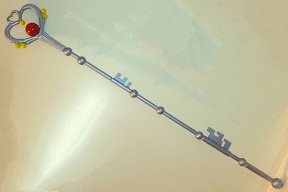


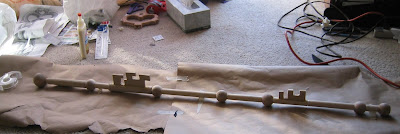

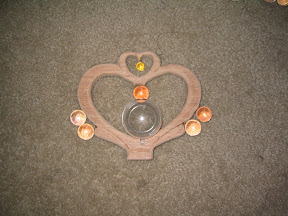


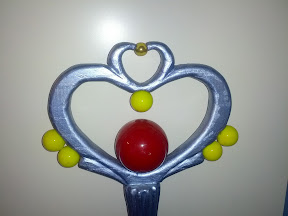
Wow, beautiful work, thank you so much for the thorough explanation, I’m building a Time Key this year, ooooo should be a challenge!
Thanks, and good luck. 🙂 Feel free to message me on facebook if you have any questions.
This is the most beautiful handmade staff I have ever seen. I am cosplaying as Sailor Pluto for the 2014 Anime Banzai and wanted to send my father the instructions you put on here on how to make it. Do you by chance have any other tips when making it by the way? And how tall is your wife? I am 5’7, would these measurements need to be adjusted? Thank you!
My wife is 5’1″, so you should definitely make a longer staff than I did. You can probably still use the same width dowels though, since the staff is really quite slender in most images in the anime.
I’m not sure if I have specific tips, but I’m happy to answer questions if you run into trouble. For me, most of this was about being patient, and accepting that sometimes things will break (especially the wooden balls @_@) and have to be redone.
Sorry for the delayed response – I don’t check here very often, so please message me on facebook (http://www.facebook.com/VolkodavCosplay) if you have questions, and good luck. 🙂
would you be willing to make this as a commision for me ?
Sorry, I don’t do commissions. 🙁 But I’m happy to answer any questions about construction.
What is the final height of the entire staff that you made?
~57″